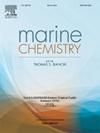Detection of impurities in m-cresol purple with Soft Independent Modeling of Class Analogy for the quality control of spectrophotometric pH measurements in seawater
Abstract
Accurate spectrophotometric pH measurements in seawater are critical to documenting long-term changes in ocean acidity and carbon chemistry, and for calibration of autonomous pH sensors. The recent development of purified indicator dyes greatly improved the accuracy of spectrophotometric pH measurements by removing interfering impurities that cause biases in pH that can grow over the seawater pH range to > 0.01 above pH 8. However, some batches of purified indicators still contain significant residual impurities that lead to unacceptably large biases in pH for oceanic and estuarine climate quality measurements. While high-performance liquid chromatography (HPLC) is the standard method for verifying dye purity, alternative approaches that are simple to implement and require less specialized equipment are desirable. We developed a model to detect impurities in the pH indicator m-cresol purple (mCP) using a variant of the classification technique Soft Independent Modeling of Class Analogy (SIMCA). The classification model was trained with pure mCP spectra (350 nm to 750 nm at 1 nm resolution) at pH 12 and tested on independent samples of unpurified and purified mCP with varying levels of impurities (determined by HPLC) and measured on two different spectrophotometers. All the dyes identified as pure by the SIMCA model were sufficiently low in residual impurities that their apparent biases in pH were < 0.002 in buffered artificial seawater solutions at a salinity of 35 and over a pH range of 7.2 to 8.2. Other methods that can also detect residual impurities relevant to climate quality measurements include estimating the impurity absorption at 434 nm and assessing the apparent pH biases relative to a reference purified dye in buffered solutions or natural seawater. Laboratories that produce and distribute purified mCP should apply the SIMCA method or other suitable methods to verify that residual impurities do not significantly bias pH measurements. To apply the SIMCA method, users should download the data and model developed in this work and measure a small number of instrument standardization and model validation samples. This method represents a key step in the development of a measurement quality framework necessary to attain the uncertainty goals articulated by the Global Ocean Acidification Observing Network (GOA-ON) for climate quality measurements (i.e., ±0.003 in pH).

 求助内容:
求助内容: 应助结果提醒方式:
应助结果提醒方式:


